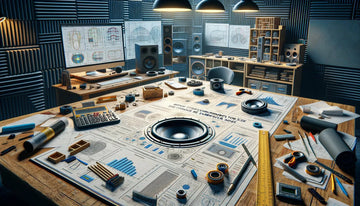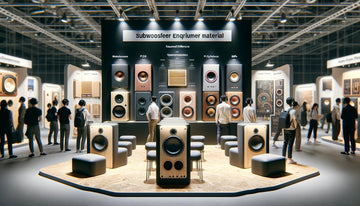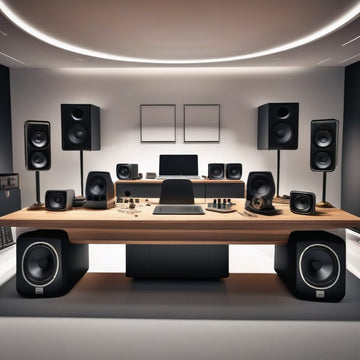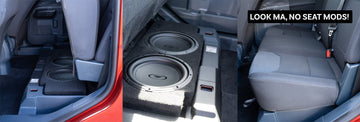Subwoofer Enclosure Size: Optimal Guide by Experts
Understanding the optimal enclosure size for subwoofers is paramount for audio enthusiasts seeking to elevate their listening experience, whether in-car audio systems or home theater setups. The enclosure size is not merely a container for the subwoofer but a critical component that significantly influences the bass output and quality. This guide delves into the intricacies of subwoofer enclosure design, emphasizing how the correct size can make or break your audio system’s sonic richness and depth. By navigating through the principles of acoustic engineering and the physics of sound, we’ll uncover why and how your subwoofer enclosure’s dimensions can dramatically affect your bass’s performance.
In the quest for the perfect bass, the journey doesn’t end at choosing high-quality subwoofers; it extends to designing an enclosure that complements its capabilities, where the optimal enclosure size for subwoofers becomes a focal point. There are various types of subwoofer boxes—such as sealed, ported, and bandpass boxes—each with unique construction, size, and port design that directly impact sound quality, bass response, and installation. This guide aims to demystify the complex relationship between enclosure size, sound quality, and bass response, providing a roadmap for novices and seasoned audiophiles.
We will dissect the variables that dictate enclosure dimensions, from the type of enclosure—sealed, ported, or bandpass—to the specific characteristics of the subwoofer and the intended acoustic environment. With this knowledge, readers will be equipped to craft or select an enclosure that meets their aesthetic preferences and, more importantly, optimizes the performance of their subwoofers for an unparalleled audio experience.
Delve into the realm of Subwoofer Enclosure Types to enhance your audio experience. Find the perfect enclosure to optimize your subwoofer’s performance, tailor your bass, and unlock the full potential of your sound system. Begin your exploration of enclosure variety for exceptional sound quality today!
Understanding the Role of a Subwoofer Enclosure
A subwoofer enclosure, also known as a sub-box, is a specially designed housing that contains the subwoofer and interacts with the sound waves it produces. It is a crucial component of the subwoofer system and directly influences the audio quality, especially the bass response. Woofers, as the primary drivers responsible for producing bass, interact with different enclosure types—such as sealed, ported, infinite baffle, and bandpass designs—to optimize bass response and overall sound quality. The subwoofer enclosure design, along with the internal volume and dimensions, significantly impacts the sound performance of the subwoofer. By understanding the role of the subwoofer enclosure and its design, you can maximize the audio quality and achieve the best bass response from your subwoofer system.
Why is the Subwoofer Enclosure Important?
The subwoofer enclosure plays a vital role in the overall sound quality of a subwoofer system. It maximizes the bass response and minimizes distortion, ensuring the subwoofer delivers deep, powerful, and accurate bass. Without a suitable enclosure, sound waves from the front and back of the subwoofer can cancel each other out, resulting in a compromised sound quality.
A well-designed enclosure also affects the frequency response of the subwoofer. It helps the subwoofer accurately reproduce lower frequencies, extending the bass response and creating a more immersive audio experience. Proper sealing and the use of damping materials, such as fiberglass or acoustic stuffing, can improve the upper frequency response, resulting in clearer and more accurate sound. Additionally, the enclosure is crucial for power handling, allowing the subwoofer to operate efficiently and deliver the best possible sound quality.
Influence of Enclosure Design
The design of the subwoofer enclosure directly impacts the audio quality, especially the reproduction of lower frequencies. A properly designed enclosure minimizes resonances and standing waves, ensuring the subwoofer’s sound is accurate and distortion-free. When designing enclosures, it is important to integrate vents—such as PVC pipes or rectangular vents—and manage space constraints to optimize airflow and ease of installation, which ultimately improves performance. This results in a tighter bass response and better overall sound quality.
By carefully considering the enclosure design, audio enthusiasts and sound engineers can optimize the subwoofer’s performance, achieving a more extended frequency response and enhancing the overall audio experience. The enclosure design can significantly impact the subwoofer’s frequency response, distortion levels, and power handling capabilities, making it a critical factor to consider when setting up a subwoofer system.
Factors Determining the Size of the Enclosure
When designing a subwoofer enclosure, several factors come into play to determine the size of the enclosure. The enclosure’s internal volume is a crucial consideration, as it directly affects the subwoofer’s ability to produce accurate bass at different frequencies. The subwoofer box design and its internal dimensions, including the width, height, and depth, all play a role in finding the optimal enclosure size. It is important to calculate each dimension precisely to ensure optimal subwoofer performance. Furthermore, the size of the subwoofer itself and the space availability, whether in a car trunk or a room, need to be considered when determining the size of the enclosure.
The Significance of Internal Volume
The internal volume of the subwoofer enclosure, often measured in cubic feet, is a critical factor in achieving the best possible bass response. For more precise calculations, especially in custom designs or complex shapes, internal volume can also be measured in cubic inches. The size of the enclosure affects the volume of air the subwoofer has access to, directly impacting the tuning frequency, bass extension, and overall performance of the subwoofer system.
By optimizing the enclosure’s internal volume, audio enthusiasts can ensure that the subwoofer operates within the ideal parameters, maximizing its efficiency and bass output. A larger internal volume allows the subwoofer to move air more freely, resulting in deeper and more resonant bass, while a smaller volume may provide tighter, more controlled bass. Achieving the correct internal volume for a subwoofer enclosure is crucial for a well-balanced sound experience.
Considering Subwoofer Size and Space Availability
When determining the size of the subwoofer enclosure, it is essential to consider the size of the subwoofer itself and the available space where the enclosure will be installed. Different subwoofer sizes require varying enclosure dimensions to ensure optimal performance.
For car audio installations, the trunk of a car can provide limited space, and it’s essential to choose a subwoofer and enclosure size that fits within these constraints. When selecting the enclosure size, also consider the ease of install to ensure that both the enclosure and any vents can be properly installed in the available space. Similarly, in home theater setups, the available space in the room should be considered when selecting the size of the subwoofer enclosure.
Balancing the subwoofer’s size and the enclosure’s dimensions is crucial for achieving a seamless integration, ensuring the subwoofer operates at its best within the space available.
Types of Enclosures: Sealed or Ported?
There are two main types of subwoofer enclosures: sealed enclosures and ported enclosures. Understanding the characteristics of each type can help you choose the proper enclosure for your subwoofer system.
As the name suggests, a sealed enclosure is airtight and has no vents or ports. This design offers a compact size and delivers a tight, controlled bass response. Sealed enclosures are less sensitive to the subwoofer’s parameters, providing consistent performance across different audio setups.
On the other hand, ported enclosures, also known as vented enclosures, utilize a tuned port to enhance bass output and efficiency, particularly at lower frequencies. Ported boxes, also known as vented or bass reflex enclosures, require careful tuning of port size and length to optimize low-frequency output and prevent damage. The ported design allows the subwoofer to produce deeper bass with more excellent excursion and air movement.
Characteristics of Sealed Enclosures
Sealed enclosures offer several unique characteristics that make them popular for subwoofer systems. These enclosures provide a tighter bass response, making them ideal for accurate and controlled bass reproduction. The sealed design reduces the chances of distortion, allowing for a cleaner sound output.
Additionally, sealed enclosures have a more even power handling, making them less likely to suffer from amplifier clipping, which can degrade the sound quality. Moreover, the sealed design also helps minimize room acoustics' impact on the subwoofer's bass response, ensuring a more predictable and reliable audio experience.
Features of Ported Enclosures
Ported enclosures offer distinct features that cater to different audio preferences. They utilize a tuned port, often a tube or a vent, to enhance bass response and improve the subwoofer’s overall efficiency, especially at lower frequencies. Here are some key features of ported enclosures:
-
Increased bass output: Ported enclosures allow the subwoofer to produce more bass output than sealed enclosures.
-
Extended bass response: The ported design enhances the subwoofer’s low-frequency extension, resulting in a more profound bass response.
-
Greater sound pressure levels: Ported enclosures can deliver higher sound pressure levels, making them suitable for applications with louder bass.
-
Port area and tuning: The size of the port area and proper tuning of the enclosure impact the bass response and the subwoofer’s overall performance.
-
Port noise control: Proper design and construction techniques help minimize port noise, which can occur at higher volume levels. Using round ports and rounding over the edges of the port can further reduce turbulence and unwanted noise.
How does Enclosure Size Impact Sound Output?
The size of the subwoofer enclosure directly impacts the sound output and the bass response of the subwoofer system. The enclosure size determines the airspace around the subwoofer, influencing the subwoofer’s ability to move air and produce sound waves.
A larger enclosure allows the subwoofer cone to move more freely, resulting in increased sound output, particularly in the lower frequencies. On the other hand, a smaller enclosure can provide a tighter, more controlled bass response, albeit with a slight sacrifice in sound output. Additionally, adding stuffing to the enclosure can decrease the effective internal volume by up to 20%, which can further influence the system's frequency response.
Audio enthusiasts can balance sound quality and bass response by selecting the right enclosure size, achieving the best audio performance for their subwoofer systems.
Sub-Enclosure Size and Bass Response
The size of the subwoofer enclosure directly correlates with the bass response of the subwoofer system, especially in the lower frequency range. A larger enclosure offers more airspace, allowing the subwoofer to move a greater air volume, resulting in a more profound bass response. This is particularly beneficial for reproducing the lower frequencies accurately, which is critical for a rich, immersive audio experience.
On the other hand, a smaller enclosure provides a tighter bass response, focusing on the mid-bass frequencies. While a smaller enclosure may not produce the same deep bass as a larger enclosure, it can still deliver a punchy, well-defined bass response.
Balancing the enclosure size to complement the subwoofer's parameters is critical to achieving the desired bass response, ensuring the subwoofer system performs optimally across the frequency spectrum.
Comparing Large and Small Enclosures
Large and small enclosures offer distinct bass responses, each with strengths and characteristics. Understanding the differences between these enclosure sizes can help audio enthusiasts tailor their subwoofer systems to their specific audio preferences. Here are some key points to consider:
-
Larger enclosures: Larger enclosures provide a greater air volume, resulting in a more profound bass response and a more impactful sound. They are ideal for a more immersive audio experience with extended low-frequency reproduction.
-
Smaller enclosures: Smaller enclosures offer a tighter bass response, focusing on the mid-bass frequencies and delivering punchy, well-defined bass. They are suitable for applications where space is a constraint or when a more controlled bass response is desired.
-
The choice between larger and smaller enclosures depends on personal sound preferences, available space, and the specific audio setup, with each size offering its unique contribution to the overall sound quality.
For example, a large enclosure might be used in a home theater system to achieve deep bass, while a small enclosure could be chosen for a compact car installation where space is limited.
Understanding the Role of Air Space in Bass Response
Air space, also known as airspace, is a critical element in the design of a subwoofer enclosure. It refers to the air volume within the enclosure surrounding the subwoofer. The air space plays a significant role in determining the quality of the bass response produced by the subwoofer system. Achieving the proper volume for your subwoofer's specifications is essential to ensure optimal performance, accurate sound, and to prevent potential damage.
By providing the subwoofer with the right volume of air, the enclosure allows the subwoofer to move air freely, resulting in better bass response. The air volume within the enclosure influences the tuning frequency, bass extension, and overall sound quality of the subwoofer. Achieving the optimal air space ensures that the subwoofer performs at its best, delivering deep, powerful, and accurate bass.
The Impact of Air Space on Sound Quality
The air space within the subwoofer enclosure directly impacts the sound quality produced by the subwoofer system. The volume of air surrounding the subwoofer influences the way it moves, allowing for a more accurate and robust bass response.
Proper air space allocation plays a crucial role in maintaining the sound quality of the subwoofer, preventing distortion, and preserving audio fidelity. Insufficient airspace can result in backpressure on the subwoofer, limiting its cone movement and impacting the sound quality. Conversely, excess airspace can lead to a loss of bass response and a muddier sound.
By carefully considering the air volume within the enclosure, audio enthusiasts can optimize the sound quality of their subwoofer systems, ensuring a more immersive, true-to-life audio experience.
Balancing Air Space and Enclosure Size
The optimal bass response in a subwoofer system depends on the air space and enclosure size balance. Achieving this balance is crucial for optimal sound performance. When tuning a subwoofer enclosure, audio enthusiasts and sound engineers aim to find the sweet spot where the air space complements the enclosure size, resulting in the desired bass response. This involves tuning the enclosure design, port size, and other parameters to meet the subwoofer's requirements. Audio enthusiasts can achieve superior bass response and sound quality by striking the right balance between air space and enclosure size, offering an immersive listening experience.
The Effect of Number of Drivers on Enclosure Size
The number of subwoofer drivers in a subwoofer system significantly influences the enclosure size. Enclosures designed for different numbers of drivers have distinct parameters and internal volumes to accommodate the specific requirements of the subwoofer drivers.
Multiple subwoofer drivers often require larger enclosures to provide adequate air space for each driver, while a single-driver setup can work efficiently in a smaller enclosure. Moreover, the power handling of the subwoofer system also impacts the enclosure size, as higher power handling capabilities may necessitate larger enclosures for proper cooling and reduced distortion.
Single Driver vs Multiple Drivers: What's the Difference?
The choice between single and multiple drivers in a subwoofer system depends on the desired sound output and the specific audio setup. Here's a comparison of the two configurations:
Single driver:
-
A single-driver subwoofer system can work efficiently in a smaller enclosure, making it an ideal choice for space-constrained setups.
-
A single-driver setup's power handling is generally lower than multiple drivers, but it can still deliver an impressive bass response.
-
A single-driver setup may provide a tighter bass response, focusing on the mid-bass frequencies, which can be desirable for specific audio preferences.
Multiple drivers:
-
Multiple drivers allow for increased sound output, delivering a more powerful bass response, particularly in larger enclosures.
-
They offer higher power handling capabilities, enabling them to handle more power and produce louder bass, suitable for audio enthusiasts looking for a more impactful audio experience.
-
Multiple drivers often require larger enclosures to provide adequate air space for each driver, resulting in a larger overall subwoofer system size.
-
Choosing between a single driver and multiple drivers depends on personal sound preferences, available space, and the desired bass response for a particular audio setup.
Evaluating Enclosure Size Based on Number of Drivers
When considering the optimal enclosure size for subwoofers, it's vital to account for the number of drivers. The quantity of subwoofer drivers present directly influences the required enclosure size. Different numbers of drivers necessitate varied assessments for sub-enclosure size, as the specific number of drivers dictates the necessary size specifications for the enclosure. Ultimately, the number of drivers plays a pivotal role in determining the overall assessment of subwoofer enclosure size, making it a crucial factor to consider in achieving the best audio quality.
Speaker Enclosure Materials
Selecting the right materials for your subwoofer enclosure is fundamental to achieving both exceptional sound quality and long-lasting durability. Medium density fiberboard (MDF) stands out as the preferred choice for most enclosures due to its high density, rigidity, and cost-effectiveness. MDF’s solid structure helps minimize unwanted vibrations and resonance, ensuring that your subwoofer delivers clean, accurate bass.
Material thickness is another critical factor. For enclosures with a total volume less than 0.5 cubic feet, a minimum thickness of 1/2” to 5/8” is recommended. Larger enclosures benefit from 5/8” or even 3/4” thick panels, which provide the necessary rigidity to withstand the powerful air pressure generated by the subwoofer. Using high-quality wood glue in combination with screws or nails ensures that the speaker enclosure remains airtight and structurally sound, preventing air leaks that can degrade sound quality. By prioritizing robust materials and proper construction techniques, you’ll create a subwoofer enclosure that not only enhances your system’s performance but also stands the test of time.
Damping and Sound Absorption
Incorporating effective damping and sound absorption within your subwoofer enclosure is essential for achieving superior sound quality. Damping materials, such as fiberglass, Dacron, or long fiber wool, are used to reduce internal resonance and vibrations that can color the sound or introduce distortion. A general guideline is to use about 1.5 pounds of damping material per cubic foot of enclosure volume, which helps to control unwanted energy and maintain clarity in the bass response.
Sound absorption goes hand-in-hand with damping, targeting the reduction of internal reflections and echoes that can muddy the frequency response. Acoustic foam or specialized sound-absorbing panels can be strategically placed inside the enclosure to smooth out the sound and deliver a more accurate, natural bass. The key is to use enough material to be effective without overfilling the enclosure, which could restrict airflow and negatively impact the subwoofer’s performance. By carefully balancing damping and absorption, you’ll ensure your subwoofer enclosure delivers tight, controlled, and high-fidelity bass.
Enclosure Construction
Building a high-performance subwoofer box requires careful attention to enclosure construction. Start by precisely calculating the internal dimensions to achieve the correct box volume, which is vital for proper tuning and optimal bass response. Whether you opt for a sealed enclosure (sealed box) for its simplicity and tight bass, or a ported enclosure (ported box) for deeper bass and greater efficiency, the construction process must be meticulous.
For ported enclosures, pay close attention to the port diameter and length, as these directly affect the tuning frequency and the quality of the low bass response. Use sturdy, rigid materials and ensure all panels are cut accurately and assembled with strong joints to prevent air leaks. Adding hardware cloth or screening material can reinforce the enclosure and protect it from the intense vibrations produced by the subwoofer. Every detail, from the placement of the port to the thickness of the walls, contributes to the overall performance, so take the time to build an enclosure that truly accommodates your subwoofer’s needs and maximizes your system’s bass potential.
Vent and Port Length Considerations
When designing a vented enclosure, the dimensions and placement of the vent or port are critical to achieving the desired sound quality and tuning frequency. The port length and diameter must be calculated based on the enclosure volume and the subwoofer’s specifications. A longer port typically lowers the tuning frequency, allowing for deeper bass, while a shorter port raises the tuning frequency for a punchier sound. The port diameter is equally important—larger diameters improve airflow and reduce the risk of port noise, but must be balanced with the enclosure’s total volume.
Using a scientific calculator or an online port calculator can help you determine the optimal port length and diameter for your specific setup. Additionally, consider the orientation and placement of the vent within the enclosure, as directing airflow toward the listening area can enhance the perceived bass response. By carefully planning your vented enclosure’s port dimensions and layout, you’ll ensure your subwoofer delivers powerful, clean, and distortion-free bass.
Steps to Designing an Optimal Subwoofer Enclosure
Designing an optimal subwoofer enclosure involves precise steps to ensure superior audio performance. Start by measuring and planning the design, considering the subwoofer’s parameters, calculating the required airspace, and planning the internal dimensions. One method for determining optimal proportions is to multiply the first panel dimension by 1.62 (the Golden Ratio) to calculate the next dimension. Then, focus on maximizing dB performance with tips like using the best way to caulk MDF, ensuring the trunk of my Nissan sedan or pickup truck can handle the giant box, and avoiding common mistakes. Lastly, consider critical factors like square inches of port area and amps to decide on the proper enclosure for your subwoofer.
Measuring and Planning the Design
Meticulous planning and precise measurements are crucial to ensure an optimal subwoofer enclosure. The design process relies on accurate measurements and comprehensive planning, making it critical to measure the dimensions and plan the design meticulously. Thorough measurements and detailed planning are integral to the enclosure design, as the process demands precision and careful planning.
Determining the Subwoofer's Parameters
Understanding the importance of a subwoofer's power handling is crucial for achieving optimal performance. The subwoofer's frequency response directly influences its enclosure design, making it a key parameter to consider. S parameters are essential in determining the subwoofer's parameters, providing valuable insights into its behavior. Additionally, efficient enclosure design requires careful consideration of the subwoofer's voice coil, ensuring the overall system functions at its best.
Calculating the Required Airspace
Calculating the cubic feet of air volume is crucial in subwoofer box design. Often, you may need to convert measurements from cubic inches to cubic feet to ensure accurate volume calculations. It is essential for determining the right size of the enclosure, which directly contributes to better bass response. The enclosure’s internal volume significantly impacts the subwoofer’s performance, and proper tuning of the airspace is vital for achieving the desired sound quality. Ensuring the proper airspace is the best way to start the subwoofer enclosure design process.
Planning the Internal Dimensions
When optimizing the sound quality of subwoofers, planning the internal dimensions of the enclosure plays a critical role. The size of the enclosure directly impacts the bass response, making it essential to achieve the correct dimensions for tighter and more accurate bass. Moreover, designing the subwoofer box to accommodate the right speakers is crucial for overall sound quality. Additionally, the port area within the subwoofer enclosure significantly influences the lower frequencies, making it an essential factor to consider in the planning process. It is also important to ensure that the surface area of the port or diffuser is sufficient to maximize airflow and achieve proper tuning.
Enhancing the Performance of Your Subwoofer Enclosure
Enhancing the performance of your subwoofer enclosure can be achieved by maximizing dB performance and avoiding common mistakes in the design process. Considering factors like trunk space in sedans, pickup trucks, and hatchbacks, you can determine the best way to build a giant box using MDF and caulk for optimal sound quality. When space is limited, the vent pipe or duct can be allowed to stick out or bend inside the enclosure to accommodate the design. Additionally, understanding the square inches of the port area, matching the woofer with suitable amps, and considering JL Audio recommendations can further enhance the overall performance of your subwoofer enclosure.
Tips for Maximizing dB Performance
To enhance the subwoofer's dB performance, it is crucial to implement the appropriate subwoofer box volume and ensure the correct size of the subwoofer enclosure. The ported design can also boost the subwoofer's power handling, while proper port size and width significantly maximize dB performance. Utilizing the right subwoofer enclosure size is essential for optimizing dB output.
Car Subwoofer Enclosures
Designing a subwoofer enclosure for your vehicle presents unique challenges and opportunities. Car subwoofer enclosures must be tailored to fit within the available space while still providing the internal dimensions, box volume, and port length required for optimal performance. Whether you choose a sealed enclosure for tight, accurate bass or a ported enclosure for greater output and deeper bass response, the use of medium density fiberboard (MDF) ensures durability and minimizes unwanted vibrations.
Incorporating damping and sound-absorbing materials inside the enclosure can significantly enhance sound quality by reducing resonance and smoothing the frequency response. Proper vent placement and orientation are also crucial, as directing the port or vent toward the vehicle’s cabin maximizes bass impact. When planning your car subwoofer enclosure, consider the subwoofer’s power handling, the desired bass response, and the specific space constraints of your vehicle. By carefully balancing these factors, you’ll create a subwoofer enclosure that delivers powerful, high-quality bass tailored to your driving environment.
Deciding on the Right Enclosure: What Factors to Consider?
When deciding on the proper subwoofer enclosure, factors include the car trunk size, port area, and size, overall sound quality and bass response, cubic feet of airspace, and internal dimensions. It's also important to check for and seal any holes in the enclosure to prevent air leaks and maintain optimal sound quality.
Key Considerations When Choosing an Enclosure
When choosing an enclosure, vital factors come into play. Considering the subwoofer’s excursion, sound quality and performance are crucial. Understanding the internal volume and its impact on cone movement is essential for selecting the right enclosure size. Additionally, the ported design significantly affects subwoofer performance, making it a key consideration. Using proper mounting techniques, such as braces, cleats, and sealants, is also important to ensure the enclosure is rigid and airtight. Considering these factors is the best way to ensure optimal sound quality and subwoofer functionality.
How Does the Right Enclosure Size Contribute to Sound Quality?
Achieving optimal sound quality heavily relies on selecting the right subwoofer enclosure size. The internal dimensions of the enclosure play a crucial role in determining sound quality, with larger enclosures typically contributing to improved subwoofer performance. Proper subwoofer box design is essential for achieving the desired bass response and sound quality.
To achieve the best sound quality and performance, finding the optimal enclosure size for your subwoofers is crucial. The size directly affects bass response, sound output, and overall audio experience. Consider internal volume, subwoofer size, and available space when choosing between sealed or ported enclosures. Measure and plan dimensions, determine subwoofer parameters, and calculate the required airspace to design the perfect environment. When installing vents, ensure there is adequate clearance between the vent opening and the enclosure wall to optimize airflow and pressure regulation. Maximize dB performance by following tips and avoiding common mistakes. Choose the right enclosure size to enhance sound quality and elevate your audio experience.
The Science Of Bandpass Enclosure Sound Characteristics
8 inch subwoofer enclosures guide Vehicle Specific Subwoofer Enclosures: The Ultimate Guide





